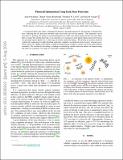Photocell optimization using dark state protection
Abstract
Conventional photocells suffer a fundamental efficiency threshold imposed by the principle of detailed balance, reflecting the fact that good absorbers must necessarily also be fast emitters. This limitation can be overcome by "parking" the energy of an absorbed photon in a dark state which neither absorbs nor emits light. Here we argue that suitable dark states occur naturally as a consequence of the dipole-dipole interaction between two proximal optical dipoles for a wide range of realistic molecular dimers. We develop an intuitive model of a photocell comprising two light-absorbing molecules coupled to an idealized reaction centre, showing asymmetric dimers are capable of providing a significant enhancement of light-to-current conversion under ambient conditions. We conclude by describing a road map for identifying suitable molecular dimers for demonstrating this effect by screening a very large set of possible candidate molecules.
Citation
Fruchtman , A , Gómez-Bombarelli , R , Lovett , B W & Gauger , E M 2016 , ' Photocell optimization using dark state protection ' , Physical Review Letters , vol. 117 , no. 20 , 203603 , pp. 1-6 . https://doi.org/10.1103/PhysRevLett.117.203603
Publication
Physical Review Letters
Status
Peer reviewed
ISSN
0031-9007Type
Journal item
Description
This work was supported by the Leverhulme Trust (RPG-080). EMG is supported by the Royal Society of Edinburgh/Scottish Government. RGB thanks Samsung Advanced Institute of Technology for funding. AF thanks the Anglo-Israeli association and the Anglo-Jewish association for funding.Collections
Items in the St Andrews Research Repository are protected by copyright, with all rights reserved, unless otherwise indicated.

